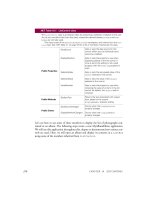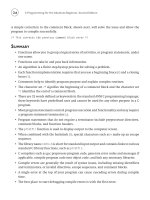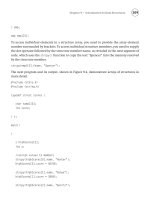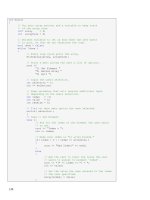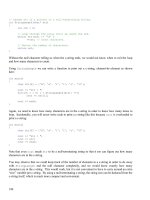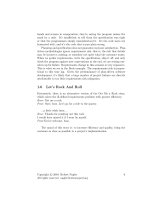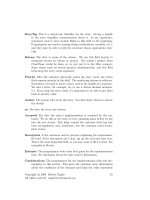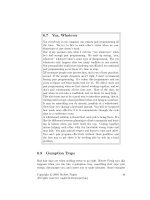Planning Extreme Programming - kent beck martin fowler phần 8 ppsx
Bạn đang xem bản rút gọn của tài liệu. Xem và tải ngay bản đầy đủ của tài liệu tại đây (78.19 KB, 17 trang )
Various events cause the team to do a little release planning. The
customer adds and changes priorities of stories, developers esti-
mate stories, and team notices if it has too much, or too little to
do.
As you are doing release planning, you’ll find there are several things
you need to do. In this chapter we talk about the various events in
release planning, and how you react to them.
Measuring Velocity
You can think of each iteration as a box, each of which can hold a
limited number of wine bottles. The key question to any oenophile is
how many bottles can you fit in a box? You could measure the box,
measure the bottles and do some geometric analysis, you could form a
committee of august persons, or you could just try it and see.
We like the latter approach. At the end of each iteration we measure
how much stuff got done. We assume that, on average, we’ll get the
same amount of stuff done next time. Life being what it is the amount
of stuff will change from iteration to iteration, but we should see a rela-
tively steady number over time.
Counting stories is not quite so easy as counting wine bottles, as not
all stories are of the same size. So we have to measure the size of each
story. At the end of each iteration we look at all the stories that got
done, and we record how many weeks of ideal time it took to do each
story. We then add up all the ideal time in all the stories, and that tells
us how much ideal time there is in each iteration.
Chapter 21
Release Planning Events
116
Following this simple rule violates one of the dictums of project man-
agement, "Work expands to fill the available space." The project man-
ager on one of Kent’s projects recently allowed as to how this just
wasn’t true, since the team had delivered 37 days worth of stories after
having initially committed to 23, and done it with two people sick the
entire time.
Changing the Priorities of Stories
Businesses often change their priorities. By only committing to one
iteration’s worth of stories at a time the customer is guaranteed a
chance to make priority decisions based on up-to-the-minute informa-
tion about the priority and cost of the stories.
Adding a story
If you compare XP to many of the other methodologies out there,
the biggest difference to customers is the fact that they don’t have to
commit to a detailed specification of everything they want before devel-
opment begins. In other words we consider requirements creep to be
perfectly reasonable and rational behavior. The requirements can creep
wherever they like as long as we know where they are going and the
customer is informed of the consequences. Indeed we encourage the
requirements to crawl around and find whatever it is the customer
needs.
The customer can add a new story at any time. They write the story
as we describe in Chapter 18. Development then estimates the story in
ideal effort. Now the customer can pick the story for any iteration, sub-
ject to Yesterday’s Weather. Unless the plan has a lot of slack there will
need to be a fair bit of moving stories. That’s fine too. The customer
moves stories as much as they like to make room for the new story and
then plops it in.
Rebuild the Release Plan
Most of the things we talk about are small scale changes to a plan.
You have to defer a few stories, move some stories about. Little changes
like this keep the plan in good shape, but sometimes you need some-
thing a good bit more significant.
117
You need to rebuild the plan in the following circumstances
✧
When the pile of deferred stories has got too far. A few stories
deferred till later is not worth rebuilding for, but if enough of
them mount up that you are sure you aren’t going to get every-
thing done, it’s time to do something about it
✧
If the team’s velocity changes, then all the assumptions for the
release plan are broken and you need a new release plan
✧
If the team is doing stories at a faster rate than planned and you
find stories denuded from later iterations.
A rebuild begins with development re-estimating the stories. The
original estimates were a good guess at the time, but since then every-
one will have learned, and a rebuild is a good time to take this learning
into account. During the re-estimate development can use the actual
figures from recent stories to better calibrate their estimates. This re-
estimating is particularly important early in development as the early
release plans will be the least accurate as there is little history to go on.
Once development has re-estimated the stories the customer picks a
pile of stories that will fit. Just hold your nose and do the math. If you
are running at around 8 weeks worth of stories per iteration, and you
have 3 iterations to go, then the customer picks 24 weeks worth of sto-
ries for this release, and will get the remainder of the stories as soon
thereafter as possible.
You should expect to rebuild the plan every three or four iterations.
You don’t want to do it all the time, as it takes a fair amount of time,
but it does need doing regularly. Think of it as changing the oil. You
don’t have to do it, but you’d be stupid not to.
118
The first plan is the hardest and least accurate part of release
planning. Fortunately you only have to do it once.
Making the First Plan
So now you know what a release plan looks like, and how you use it.
It should be clear that the accuracy of plan depends on the accuracy of
its estimates, and the accuracy of the estimates depends on the history
of the project. So with the first plan you have no history, so your esti-
mates are flaky. What does this make the plans?
Flaky. (Think Kramer with too much coffee.)
But you still need a plan to even get started. The plan gives you
something to track against so you can assess progress. It gives you a
framework of stories which allow you to capture what happens and
build up the history to make the later plans better. The first plan is
always high on expectations and usually a big let down.
The plan has two main areas of uncertainty: the velocity of the team
and size of the stories. Here’s a few tips on how to do the best you can.
The key to velocity is that it’s a measured thing. As such you won’t
get a decent picture of velocity until several iterations into the project.
Before you can measure, the best you can do is to guess.
One way to gauge the velocity is to measure progress during the
exploration phase. During the exploration phase use tasks much along
the lines of an iteration plan. Monitor progress and track the ideal time
people report much as you do with iteration planning. See how much
ideal time people get done and use that as a basis. Every time a pro-
grammer says, "I’ll get that done in a day," notice how long it actually
Chapter 22
The First Plan
120
takes. If "a day’s worth of work" generally takes three days on the cal-
endar, then you could guess the team’s velocity as #people * weeks/
iteration / 3.
If there’s a similar project in your organization you could use their
velocity to help estimate yours. They have six people on three week iter-
ations. That’s 18 calendar weeks per iteration. Their velocity is 6. You
have four people and are doing 2 week iterations. That’s 8 calendar
programming weeks per iteration. So a guess at your velocity is 6 * 8/
18 which is about 2.
Story estimates are tough at first. The approach we’ve had the best
luck with is to get the team to start with the stories they feel the most
comfortable estimating. Once they have done those do the others by
comparison, much as you do with historical estimates. To estimate
those first few stories, have people ask themselves, "If this story was all I
had to do, and I had no distractions, how long do I think it would
take?"
You may have another team that’s done similar work. How can you
use that experience? One thing to not do is to get them to estimate the
stories. That breaks the rule that those who do should be those who
estimate and will lead to lack of commitment and falling morale. Don’t
do that.
You can have the team look at the history of the other team and
come up with their own gauge based on that. But you have to be care-
ful not to let comparisons get too sticky. Once you start reasoning
about how fast one team is compared with another you’ll get all sorts of
emotional reactions that will distort everyone’s thinking. It can be
helpful in flushing out all the issues that may come up. It can also be
handy in comparing effort between tasks: “it took them half as much
again to get the objects hooked into the relational database, so let’s
start with the same proportions for us”.
Choosing your Iteration Length
How long should an iteration be? There are a lot of people who favor
iterative development, but they don’t all answer that question the same
way. Some people say that an iteration can be as long as six months. We
go in the other direction, iterations should be short – between one and
three weeks. We favor two, and a recent survey on the XP egroup
121
(
/>) showed that
two and three were the most popular choices.
Why make them so short? One of the key things we want from a plan
is an indication of progress; how far have we come, how far have we to
go? Iterative development is good at providing that, because each itera-
tion delivers working, tested code – which is hard to fudge. But these
milestones only occur at the end of an iteration. So the longer the itera-
tion, the more risk you run of sliding just a little bit out of control. So
you want each iteration to be as short as possible, so that you know
where you are as frequently as possible.
But there is such a thing as too short. Each iteration implies some
overhead. Making sure the acceptance tests are running, planning the
iteration, reporting to management and so on. We don’t want the over-
head to be bigger than what we are trying to do in the iteration. If it is,
we will stop planning and iterating. However, iteration overhead is kept
small by doing it all the time.
Question:
How long do your iterations last?
Choices Votes % 37 replies
<1 week 0 0.00%
1 week 7 18.92%
2 weeks 14 37.84%
3 weeks 12 32.43%
4 weeks 3 8.11%
1 month 1 2.70%
>1 month 0 0.00%
122
But don’t get too hung up about it. The world isn’t going to end if
you pick three week iterations instead of two week iterations. As long as
you are prepared to be aware of the effects of iteration length, and pre-
pared to experiment when you spot a problem, you can start most any-
where. So start with two week iterations.
Each iteration is planned by breaking down the stories for that
iteration into tasks.
The Iteration Plan is the second part of the planning picture. The
release plan is synchronized to the rhythms of business. It gives the
business people a way of thinking about sets of stories that together tell
a good story to the market. The iteration plan is synchronized to the
rhythms of programming. Two weeks is long enough to:
✧
Develop some new functionality
✧
Do a substantial refactoring
✧
Develop some infrastructure
✧
Try some experiments
✧
and, Recover from little disappointments
Unlike the release plan, the iteration plan is very much the developers
preserve. They decide how to do things and in what order. The cus-
tomer is still involved. It’s important to report progress mid-iteration
so that the customer can see what’s happening and get a sense for what
will actually happen. The customer will also get very involved if the
team finds there is too much to do and you need to cut scope.
The formal start of the iteration is the iteration planning meeting
(Chapter 23), where the developers get together to break down the
stories for that iteration into smaller tasks. We do this because we need
smaller units to track than the stories. Each task is about 1-3 ideal days
in length. Also while it’s often worthwhile to have a programmer
responsible for seeing a story through to completion, it is better for
people to sign up for the smaller tasks, to give them a chance to express
their specializations. Often there is overlap in the work needed between
Chapter 23
Iteration Planning
124
stories, and we can handle this better by using tasks. Finally, the kind of
dependencies that drive most planners crazy must be dealt with inside
of iterations.
After the iteration planning meeting someone takes on the responsi-
bility of tracking the iteration(Chapter 25). The tracker keeps an eye on
which tasks are done, and how much is left on outstanding tasks. His
job is to alert the team to problems that might come up: having too
much to do, to little to do, people over or under committed. Every day
the team has a short stand-up meeting so everyone can see what every-
one else is doing. This helps keep communication flowing across the
whole team.
Never slip the Date
One of the most important principles in planning for Extreme Pro-
gramming is that the dates are hard dates, but scope will vary. In any
project you’ll often run into the situation where there is too much to
do and you’ll be tempted to slip the date of an iteration just a little bit.
Don’t do that.
Slipping dates is one of those bad habits that is both addictive and
damaging. The damage really comes from the fact that it’s so easy to
do. At some point, however, you’ll either slip so much that you’ll lose
all credibility (and the project too), or you’ll run into some date that’s
very painful to slip, like a release date. If slipping dates is the only thing
people know how to do then that’s what will happen, and the pain is
great.
The harder but surer way to cope with too much to do is to defer
functionality. Because it’s harder it’s more important to practice doing
it. Only if the team (and especially the customer) practices this for every
iteration will everyone be ready to do this when the really important
date comes along. The most important stories are the ones the cus-
tomer decides they can live without for the moment. Those stories can
save projects.
Now it may be better to slip a release date. That’s the customer’s
decision that will involve many issues. But only if everyone has prac-
ticed deferring function will the customer have a genuine choice
between date and function. And we are constantly surprised by how
125
much "essential" functionality customers can do without when a big
date looms.
Often you can only make those hard choices when the big dates
appear, and without practice you can’t do it under pressure. As Jim
Highsmith says "I used to think Time-boxing was about time, but I’ve
learned that instead it is about forcing hard trade-off decisions
throughout the project".
The other reason not to slip dates is that you lose control. There’s
always some uncertainty within the iteration. Only at the end of an iter-
ation do you really know where you are. So you never want to put that
time off.
126
At the beginning of an iteration the team plans out its iteration
with an iteration plan. This plan breaks down the iteration into
development tasks of a few days each.
The iteration planning meeting is the first thing you do in the itera-
tion. It shouldn't take any more than a day, and most teams will do it in
under a day. All of the team should attend, plus the customer. Find a
comfortable room with plenty of whiteboard space.
Here's an overview of the sequence, this is just a summary, we'll
describe what it all means in a moment.
✧
Read out the stories for this iteration
✧
Write on the whiteboard all the tasks that need to be done for
each story
✧
Add to the list any technical tasks that need doing
✧
Developers sign up and estimate tasks up to their individual veloc-
ity.
✧
If any story isn’t completely signed up for, the customer is asked
to defer functionality
✧
If there is extra time the customer is asked to add functionality
The first thing to do is to remind everyone what's on the menu for
this iteration. It's often a good idea for the customer to read out the
stories so that everyone hears it from the customer perspective.
Listing the tasks for an iteration
Each story is a few ideal weeks of effort, so for this detail of planning
we need to break it down into a few finer grained tasks. Each task
Chapter 24
Iteration Planning Meeting
128
should be a few ideal days of effort. The tasks are development tasks, so
they don't need to make sense to the customer.
The best way to come up with the tasks is for everyone involved to
just brainstorm what they might be. Often this will involve a little
thought about how you’re going to build it. You don’t need a major
design effort here, but you do need just enough to get a good list of
tasks. Take short pass at the classes and interactions you’ll need to add
and modify. Remember that the goal is not to design everything that is
needed for the iteration, it is to help figure what the best task break-
down is. You’ll do other design sessions as part of carrying out the
tasks.
Often you’ll find some overlap between the stories. This overlap may
give you the opportunity to build software that helps satisfy several sto-
ries at once. There may be existing designs from past iterations that,
with a little refactoring, could significantly help this iteration. Add tasks
for this, it’s okay to have tasks that satisfy more than one story.
For example, several of the stories may require that as you enter text
into a field, you hunt for possible completions for that text from a given
list. It would be a shame to develop this facility three or four times,
once for each story. So make this into a task. It may be that other sto-
ries from past iterations need to have this new feature retrofitted onto
them. You might make that retrofit a separate task.
Dependencies between tasks are likely to exist. You won’t need
PERT charts or similar beasts. With a communicating team over a few
weeks you can rely on the team to sort these dependencies out. It’s
worth talking over them, for that should influence what gets done first.
However, as you’ll see, you don’t actually plan precisely when each task
gets done, or in what order the task gets done.
In the end there's no hard and fast rules for how you break some-
thing down into tasks. Use whatever approach makes sense for you. As
long as the tasks are kept short and you can write tests for them, you'll
be fine.
Technical Tasks
Most of your time will be spent in building stories. However there
are some purely technical tasks which the customer doesn't care about,
but still need to be done. These include such things as installing the
129
vendor's database upgrade, refactoring some messy bit of the system,
trying out a design idea to learn if it will be useful, improving the con-
figuration control process. Anything like this should be added to the
list. Again it's important to keep each task small, so break things up
into a few ideal days each as much as you can.
Ron Jeffries claims he can turn any technical task into a business-ori-
ented story the customer can either schedule this iteration or not.
There’s something to be said for not having any technical tasks. Once
you start down the slippery slope of setting priority for technical rea-
sons, it’s hard to stop. Dave Cleal suggests that a fixed portion of the
budget, say 10%, be set aside for the programmers to spend as they like.
We haven’t tried it, but it sounds like an interesting idea.
Measuring the velocity of a developer
Each programmer is going to able to do a certain amount of tasks
during the iteration. We figure this out by asking each programmer to
track their progress iteration-to-iteration. Then, just like the team as a
whole, a programmer can only sign up for the same number of days
worth of tasks as they completed last iteration.
Obviously there are things that can change that. If someone is spend-
ing one week of this three week iteration on vacation, then they will
only have 2/3 of their usual velocity available.
Remember that a programmer’s velocity is not a measure of her pro-
ductivity, speed, or goalkeeping ability. It just says how many tasks they
can sign up for. One person may have a low velocity because they are
naturally optimistic when estimating. Another may have a low velocity
because they spend a lot of time helping other developers. The key
thing is that a programmer’s estimating ability should improve so they
can predict how much they can get done. The absolute value of their
numbers are far less important than their accuracy.
Signing up and estimating Tasks
Once you have a list of the tasks on the whiteboard, programmers
can then start signing up for them.
By signing up, each programmer accepts the responsibility for work-
ing on that task during the iteration. The first thing they need to do is
130
to estimate how long it will take them to do the task. Most of the time
they can come up with this estimate right away. However it's also
alright for a programmer to say "I'll sign up for that, but I'm not sure
how long it'll take yet. Let me work on it for a day or so and I'll give
you an estimate then".
Any programmer can only sign up for enough tasks that fit into his
velocity. Programmers may need to break up a task and then sign up for
a piece of the result.
It's up to a programmer how they come up with an estimate. As
usual the best approach is compare it with previous work. The pro-
grammer can say, "this should take about the same time as the shipping
GUI I did last iteration". The project records will show how long that
task took, so that number can be used this time too.
Be wary of using comparable work from another programmer. We
are dealing with people, not Plug Compatible Programming Units.
Programmers do not work at the same speed, and their comparative
speeds will be different for different tasks. It's useful to let a program-
mer look at the records to help come up with an estimate, but don't do
things like "It only took Dinsdale three days to do this task, so why do
you think it'll take five?" Once you start using the records as a club,
you'll never get an honest estimate again. The most important thing
here is to get estimates as accurately as you can — if you want to com-
pare programmers' abilities don't do it during planning.
Programmers should always assume they have a partner when doing a
task, since in XP all production coding is done in pairs. It may be that a
particular partner can affect the estimate. "If Spiny will work with on
this, we can do it in two days". That's fine and indeed it reinforces the
principle that people help each other.
Programmers should also assume that they aren’t done with a task
until they have all the unit tests written and passing. "I’m done with the
coding, but I haven’t tested it yet," is a meaningless statement in XP.
Code without tests simply doesn’t exist for planning purposes.
Programmers can sign up for whatever they want to do. People can
work things they have a desire to do, which keeps them motivated.
Since motivation is the key to productivity, this is a Good Thing. Some
programmers will pick one kind of task they prefer and mostly do this.
Others like to broaden their interests by trying new things. This is a
131
Good Thing because it keeps up motivation, it allows developers to
grow their skills, and it reduces project risk.
Scut Work
Some project managers, on hearing this "signing up" practice, fear
there'll be some dirty work that doesn't get done. In practice we don't
find this is an issue. Developers are so varied that there is almost always
someone who likes doing everything. For occasional unpopular tasks
some informal and often unspoken sharing goes on.
If someone always ends up on with the short end of the stick, then
it's the coach's job to point this out to the team, and ask the team to
come up with solution. They may choose to do a more formal rotation
to take turns doing the unpopular kind of work. They may try to
recruit someone to the team who likes doing this kind of work. Pro-
grammers like solving problems, so they'll find a solution, and if they
come up with it they will make it work.
Too much to do
Once all the programmers have signed up for tasks and estimated
them, take a look at your task list. In a perfect world all the tasks will be
signed up for.
In this particular galaxy, we find often tasks are still remaining. If
that's the case you have to decide what to defer.
If you have technical tasks remaining, or you can swap story based
tasks for technical tasks, then that is one option. You have to consider
the risks involved. Can you wait another iteration to upgrade the data-
base? Sometimes a wait is the best option, but other times there aren't
any technical tasks you think you can defer.
At this point it's time to call in the customer. The developers cannot
which story based tasks to defer. Instead they have to say to the cus-
tomer "we are short 5 ideal days, we need you to remove 5 ideal days
worth of story".
At this point the customer has to choose. The customer can choose
to defer a whole story, or they can chose to split a story and defer one
of the resulting parts (see “Splitting user stories” on page 92). A cus-
tomer may choose to split several stories to get the right mix for them.
